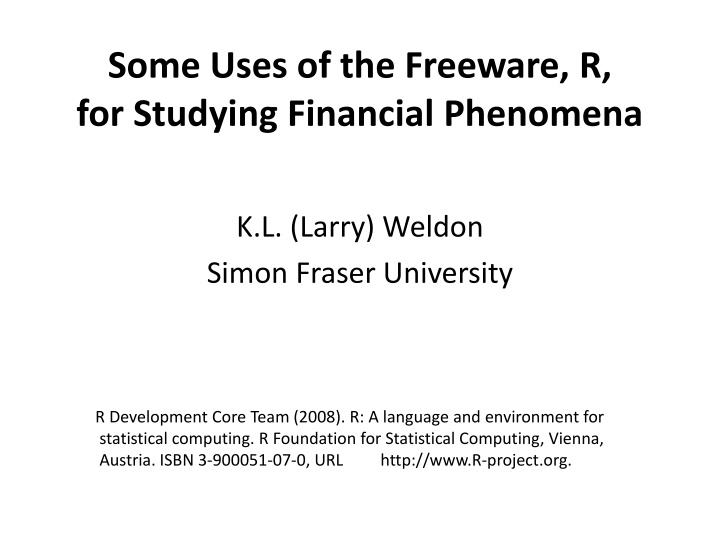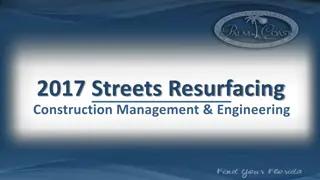
Using Freeware R for Studying Financial Phenomena
Learn how the freeware R can be utilized for studying various financial phenomena such as equities, bonds, risk assessment, mutual fund performance, and counterfactual inference approaches. Explore practical applications and insights for managing financial data and making informed decisions in the field of finance and economics.
Download Presentation

Please find below an Image/Link to download the presentation.
The content on the website is provided AS IS for your information and personal use only. It may not be sold, licensed, or shared on other websites without obtaining consent from the author. If you encounter any issues during the download, it is possible that the publisher has removed the file from their server.
You are allowed to download the files provided on this website for personal or commercial use, subject to the condition that they are used lawfully. All files are the property of their respective owners.
The content on the website is provided AS IS for your information and personal use only. It may not be sold, licensed, or shared on other websites without obtaining consent from the author.
E N D
Presentation Transcript
Some Uses of the Freeware, R, for Studying Financial Phenomena K.L. (Larry) Weldon Simon Fraser University R Development Core Team (2008). R: A language and environment for statistical computing. R Foundation for Statistical Computing, Vienna, Austria. ISBN 3-900051-07-0, URL http://www.R-project.org.
Financial Applications Equities & Bonds in Long Term Risk Assessing Mutual Fund Performance Robustness of Large Companies Management of a Hospital System
Counterfactual Inference Approach Observe complex real-world phenomenon Use parametric models for noise Simulate complex model, graph outcomes Calibrate model with global outcome data Use model to predict unobserved behavior
I. Equities & Bonds in Long Term Risk Portfolio Variability Risk (=Prob y of Loss) Canada: 50 years experience: Bonds ROR is 7% Equities ROR is 10%, Abs. daily change mean .6% sd .67% Prob (positive daily change) = .53 suggests random walk How long til Equity Advantage Realized? Go to R: tse() (and tse.run())
Observations from tse programs long term ROR for equities exceeds ROR for bonds 80% of time. when bonds better, not much better typical shocks are not large enough to affect long term trends. long term risk is inverse to short term variability Q: What is long term
Technical Analysis Illusions Apparent trends may be useless for prediction Go to R: rwalk()
II. Assessing Mutual Fund Performance Asymmetric random walk: P(+.3)=p, P(-.3)=1-p models % daily changes p is selected from a distribution like
Simulation of Fund Managers p=.54 models a poor fund manager p=.56 models a good fund manager We simulate 100 managers 5-year experience Variety of p values. Pick the best (top 15% in ROR) managers Follow them for 5 more years How do we do?
Summary of result Managers of various qualities were simulated for 5 years to observe RORs The managers that appeared to do best were selected (top 15%) These same selected managers were followed for 5 more years, assuming same quality We compare the select group with the riff- raff: not much better! Conclusion: past performance has little useful quality info.
The diversification role of funds If Risk=P(Loss), and If P(loss) of 50% or so in one year is considered risky How risky is a portfolio of risky investments? E.G. One year returns to a $1 investment
Hypothetical Portfolio 25 such companies have one-year returns that are independent. portfolio of the 25 risky companies what are typical one-year portfolio returns? goto R: risky(m=25) Phenomenon survives lack of independence
III. Robustness of Large Companies Insurance Scenario Casualty Insurance Assume: Cost of Claim = $6000 Poisson Stream of Claims p = .2/year Premium start at $1460 per year Expected gross profit = $260 actual variability depends on no. of policies go to R program insce()
Big Company Pressures Small One Suppose Premium Reduced to $1350 100 policies Chance of Loss = 25% 1000 policies Chance of Loss = 2% 100 policies 1000 policies
Summary Big insurance companies are less likely to have a loss than small insurance companies Big Insurance companies can drive smaller ones into bankruptcy by reducing premiums. (not news, but the specifics are useful)
IV. Management of a Hospital System Idea: Simulate health status for an entire lifetime (a life process) Define status for hospital admission and discharge, and death Calibrate the life process with public health data Use model to study alternative mgt. policies
Typical Life: Health Status History ---Admission ---Discharge ---Death Day Number make.life(plt.final=T)
Hospital Cure Process Fig 12 Distribution of Daily changes in Health Status while in the Hospital. Mean is about +0.02, and SD is about 0.2.
Calibration OK? Hospital admission rate: .3/1000 Length of stay: median 10 days Age in hospital: mostly >70, some young Age at death: median 80 yrs Number of lifetime hospitalizations: mean 6 All resulting from random walk!
Process Use Theory to Construct Model Use Outcome Data to Calibrate Model Use Model to Run Counter-Factual Scenarios such as .
Ways to use the simulation Suppose current hosp beds available = .3/1000 How often will capacity be breached? Expand beds to .35/1000 Same Question If avg. length-of-stay decreased by 10% Impact on bed occupancy? If admission rules liberalized (admission line ) Impact on bed requirements?
Summary R capable of producing simulation programs of practical relevance to finance and mgt. Programs can be run by anyone with internet access Software is free and has international support www.r-project.org/ Info re these particular programs weldon@sfu.ca and www.stat.sfu.ca/~weldon





